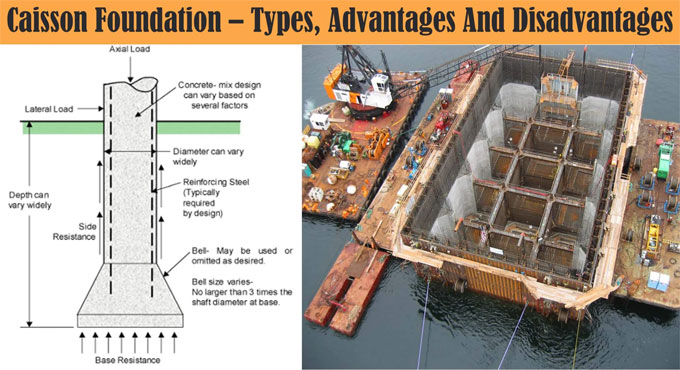
What is Caisson Foundation and How is it Used in Construction
A Caisson Foundation is basically a watertight box with the top open. It is sunk into water to gain access to the bed of the stream. It is generally made of wood, steel or concrete depending upon project requirement.
Through this boxlike chamber, the workmen can make construction work at the bottom of water bodies without being hampered by the water. Accordingly, this is mainly used to place foundations at river beds.
Caissons are generally made on shore first. Then, They are launched into the water body. The caisson is then floated to the designated spot. Then they are sunk vertically to the bottom. After ensuring that the caisson is waterproof, the water inside is pumped out to dry.
Types of Caisson Foundation:
1. Box Caisson: This is the most basic type of caisson. It is made of timber, concrete or steel. It is built on shore and floated to the foundation location and sunk to the bottom. It is basically a box without the top.
2. Open Caisson: This type of caisson has neither the top nor the bottom. When made in a cylindrical shape, it looks like a well without top or bottom. It can be built in many shapes - vertical, over, or any other option.
In case of building large bridges, a bathtub-like shape is preferred. Usually open caissons are made of steel plates welded together. RCC can be also used here, as the situation requires.
3. Pneumatic Caisson: This odd type of caisson has an open bottom but closed top. This has to be forced down to the bottom of the water by means of compressed air. Thus the name is derived. A pneumatic caisson consists of a working chamber, a shaft, and an airlock. The caisson is made of inner and outer layer of steel skins. Trusses and girders join them to form a boxlike structure.
The working chamber in pneumatic caissons is 3-4 meters tall only. It is made airtight with a special seal on top. The caisson?s bottom edge has a steel edge that cuts into the riverbed. All this facilitates working within the chamber while the caisson is being sunk. People can access the caison via the airlock.
One factor that needs to be specially cared for in pneumatic caissons is the air pressure within the working chamber. A normal human being can withstand an air pressure of 1.32 kilos per square centimeter for eight hours in moderate comfort.
For greater pressure, the work time inside a caisson has to be reduced. Even then, the maximum air pressure allowed inside pneumatic caissons is 3.75 kg/sq.cm. Also, you need to take care of compression and decompression sickness.
Advantages of using Caisson Foundation:
1. It is very economic.
2. It minimizes pile cap needs.
3. Working inside a caisson creates less vibration and noise.
4. Caisson technology is highly flexible and can adapt to most construction needs on site.
5. The caisson foundations have high axial and lateral loading capacity.
Disadvantages of using Caissons:

1. It is very sensitive to construction procedures.
2. They are not good for using in contaminated sites.
3. It needs qualified inspectors and constructing crew.

